The 25 Best Live Streaming Solutions – Everything You Need to Know in 2025
With professionals relying on online video content more than ever, live-streaming solutions are essential for corporate communications, video marketing, sales, and business development. As remote work becomes the norm, businesses increasingly depend on live streaming to stay connected and engage their audiences effectively. That’s why having a reliable live-streaming solution is crucial for every business.
Live streaming is booming in so many different industries. More than 4.6 million people watch music festivals via live streams each year while sports live streaming is also on the rise. The global video streaming industry market is now valued at $106 billion and it’s expected to grow at a CAGR of 21.5% until 2031.
Incorporating live streaming into your business’s operations requires the support of good live-streaming video solutions. They will not just host your content but provide you with tools to share, protect, and monetize your video content.
In this article, we’re going to review the 25 best live media streaming solutions in 2025, including a mix of platforms geared towards professionals and some consumer and prosumer alternatives. We’ll compare each platform based on functionality, features, streaming solution costs, and more.
Please keep in mind that live streaming solutions technology and pricing changes regularly. This post reflects the most accurate information as of April 2025.
Table of Contents:
- What is a Live Streaming Solution?
- Streaming Industry Trends and Statistics
- Free Live Streaming Services vs. Professional Solutions
- What is SaaS Video Streaming?
- What to Look for in a Streaming Solution
- The 25 Best Live Video Streaming Solutions
- Top Social Streaming Solutions
- Live Streaming Technology
- FAQs
- Conclusions
Our aim here is to help you narrow in on the best streaming solutions for you. Let’s begin!
What is a Live Streaming Solution?
A live streaming solution is a video hosting platform that supports broadcasting in real-time. These platforms are equipped with professional broadcasting tools and features, like VOD hosting, white-label video players, cloud transcoding tools, privacy and security, monetization support, global delivery, and more. All of these tools allow you to take control of your content.
Professional-grade live-streaming solutions are widely used to broadcast concerts, webinars, conferences, sporting events, corporate gatherings, and even OTT platform content. They provide high-quality broadcast tools for businesses that need a reliable streaming solution. Key features include adaptive bitrate streaming, password protection, advanced encryption, and more – ensuring a smooth and secure live streaming experience.
Compared to social media apps and consumer-grade streaming services, dedicated live streaming solutions typically offer greater reliability. However, each option has its advantages. Using a mix of professional streaming solutions, social media platforms, and consumer-grade services can be the best approach for maximizing reach and engagement.
Streaming Industry Trends and Statistics
Before we dive into the ins and outs of live streaming solutions, let’s take a quick look at the state of the video streaming industry:
- Live content holds viewers’ attention 10-20x longer than on-demand video content
- 94% of marketers believe that online video content helps to better personify their brands
- 55% of online users watch video content every day
- Video content helps retain a brand message better than static content
- Video is currently used for marketing purposes by 91% of businesses
For a deeper dive into video streaming trends in 2025, check out our dedicated streaming statistics post. It highlights why partnering with a top live streaming solutions provider is key to your business’s streaming success.
Free Live Streaming Services vs. Professional Solutions


Let’s start by addressing a common question: Why choose professional-grade live-streaming video solutions?
Many businesses and content creators begin with free or prosumer streaming options, often using platforms like YouTube, Facebook, and Instagram. These services offer built-in live-streaming features and require little to no financial investment, making them a great way to test the waters. While consumer-grade solutions have their place, they come with limitations that professional streaming platforms can overcome.
Free live video streaming solutions are valuable for some purposes, but they don’t provide much functionality for hosting video content on a larger scale. Additionally, free options come with serious privacy and security concerns, providing limited security features. Monetization tools are either hard to access or not supported at all, while tech support may not be up to your business standard.
Investing in a top-tier professional live-streaming solution comes with a cost, but it also gives you full control over your content. With this investment, you can customize the video player’s look and feel, manage quality settings, implement advanced security features, and even monetize your streams. Choosing a leading live streaming provider ensures you have access to high-quality tools designed to elevate your broadcasting experience.
What is SaaS Video Streaming?
Software-as-a-Service (SaaS) is a software delivery model that provides customers with a subscription-based live streaming solution hosted in the cloud. Many businesses rely on the SaaS model for various applications, including online software, communication tools, and payroll processing. It has also become a standard for cloud-based video streaming solutions.
SaaS video streaming software helps broadcasters address their streaming needs by providing a complete service. The solutions we’ll be comparing have developed specialized streaming software to support broadcasters.
A key advantage of these solutions is that they run in the cloud, eliminating the need for costly infrastructure to support high-quality live streaming. Instead, users pay a subscription fee to access the robust infrastructure provided by these services.
One example of a SaaS-based live-streaming solution is Dacast, which is widely regarded as one of the top options for professional live-streaming.
What to Look for in a Streaming Solution
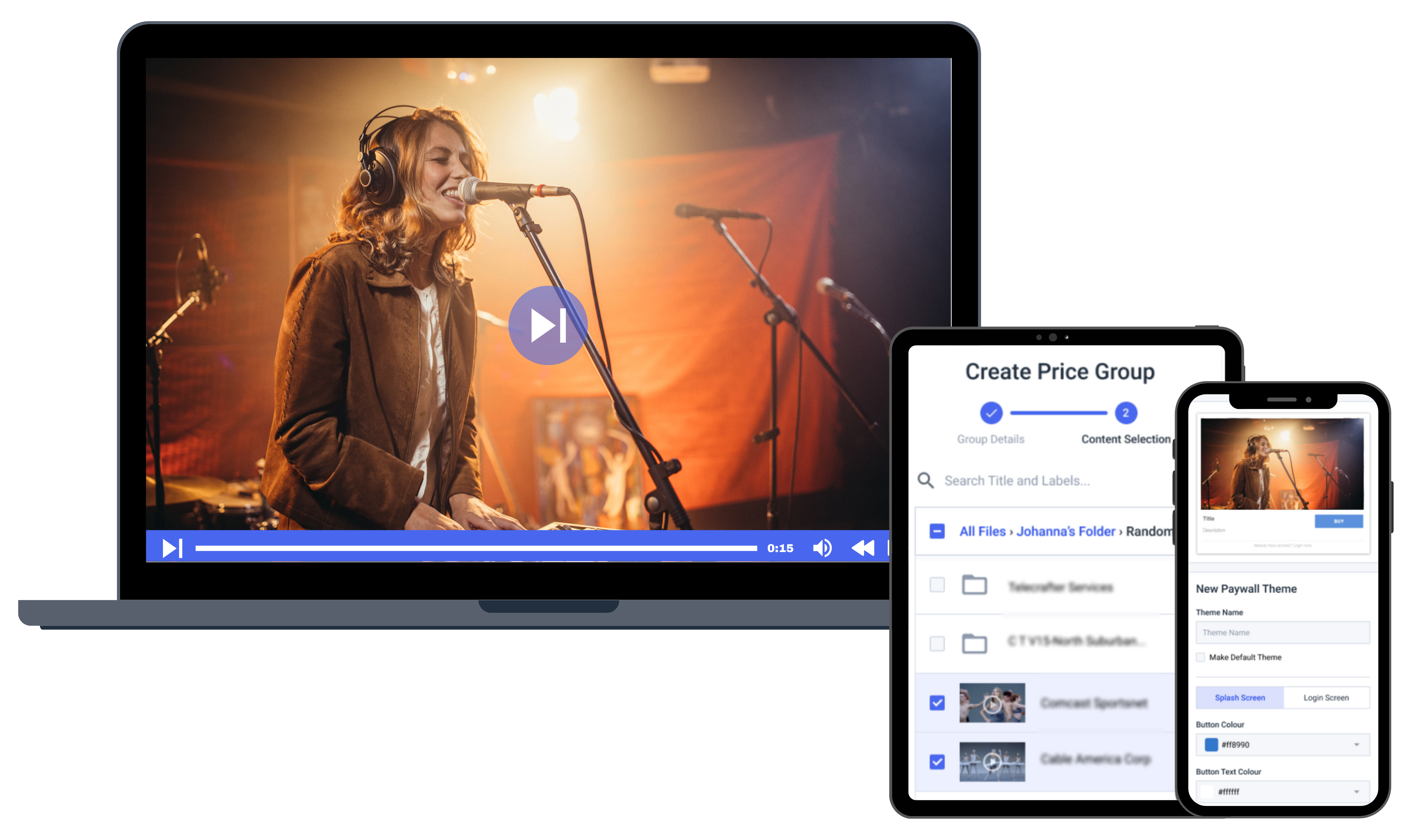

There are so many different professional-grade video streaming solutions with unique sets of features at different price points. When you’re considering which video solution you should use, there are several features to look for.
- Security features: password protection, AES encryption, geographic/domain restrictions
- Monetization: pay-per-view, subscriptions, advertisements
- Professional business video hosting tools
- Live streaming support
- 24/7 tech support
The most important thing to consider when choosing a streaming solution is whether or not it includes the tools you need to reach your specific live streaming goals.
The 25 Best Live Video Streaming Solutions
Each streaming solution comes with unique sets of key features, basic functionalities, and pricing. No corporate streaming solution is perfect, but there is one out there that’s right for your business, and now is the time to find it.
Consider all of this while we compare the top 25 live video streaming solutions for 2025 and beyond.
1. Dacast


Overview and Company History:
Dacast is a B2B SaaS live streaming platform that delivers high-quality streaming worldwide at very competitive pricing. Dacast is located in San Francisco, with offices in London.
Dacast has earned the Streaming Media Readers’ Choice Award for Best Small/Medium Business Video Platform and Runner-Up for Best Education Video Platform. In 2019, Dacast acquired the vzaar platform, which expanded our set of comprehensive VOD tools and truly made Dacast a unified streaming solution.
Basic Functionality:
Dacast provides comprehensive live streaming and online video hosting services. Broadcasters who use this streaming solution maintain 100% ownership of their content.
Among other features, Dacast offers an integrated video paywall, password protection, referrer restriction, and an analytics dashboard. You also get advanced features like adaptive-bitrate streaming that enable you to deliver a smooth live streaming experience for the viewers. They’ll be able to watch your stream without any pauses or buffering delays. With Chinese live streaming platform capabilities, delivery of content in China also means that you can reach a truly global audience.
Key Features:
Dacast’s key features include ad-free broadcasting, white-label service on all plans, and top-tier live-streaming CDN delivery. Reliable 24/7 phone support is also available for scale and event plans.
Detailed Features:
- Secure, global content delivery, including industry-best video hosting
- 24/7 tech support with all plans, including email and live chat
- Video security features, including password protection and encryption
- RTMP Encoder for ingesting HLS streaming
- Player API access for 3rd party player integration
- Video API access on premium plans (scale and event)
- Adaptive multi-bitrate streaming
- Cloud-based video transcoding
- Real-time analytics
- Ad-free streaming
- RTMP Streaming Platform for robust transmission
- Multi-user access on Scale and Custom plans
- Zoom live streaming integration for meetings and live events in real-time
- Expo 2.0 galleries video portal for immersive video experiences
- AES video encryption for advanced streaming security
- Advanced API to build your own video CMS
Pros:
- Live streaming and VOD streaming packages on all pricing plans
- RTMP (real-time messaging protocol) ingest, playback, and streaming support
- Unlimited concurrent viewers
- White label and branding control
- Embeddable HTML5 video player
- SVOD, AVOD, and TVOD monetization options
- Unlimited live channels
- Mobile device support
- Live stream recording
- China Video Hosting
- Plans for every budget
Cons:
- Dacast does have a learning curve, but they provide you with lots of support to help you learn the platform.
Upload Guidelines and Specs:
- Minimum dimension: None (but 240p is the recommended minimum)
- Maximum dimension: 1080p or 4K (depends on the user’s hardware and internet)
- Video aspect ratio: No restrictions (but 16:9 is the default)
- Max file size: None
- Max video length: None
- Total file storage: 10-1000GB (depends on plan)
- Compatible video formats: MP4 (preferred), MOV, M4V, M2V, AVI, MPG, FLV, WMV, MKV, WEBM, OGV, MXF, ASF, VOB, MTS
Pricing:
Dacast has multiple live streaming pricing plans. Here is a quick summary of all plans:
- Starter plan: ideal for newcomers with 2.4 TB of bandwidth and 500 GB of storage per month, at just $39 per month billed annually.
- Event plan: for organizations who’d rather not sign a contract and want to purchase bandwidth separately to live stream an event. It offers 6 TB of bandwidth upfront, 250 GB of storage, and costs just $63 per month (or $750/year). Additional data and storage can be added as needed.
- Scale plan: includes 24 TB of bandwidth per year, with 2000 GB of storage for $165 per month billed annually. These Scale pricing plans add phone support, monetization paywall, an M3U8 online player for live channels, ad insertion, white-label C names, and video API access.
- Custom plan: if your enterprise business has high-volume streaming needs, you can contact Dacast for a custom plan tailored to your needs.
Broadcasters can contact Dacast directly to learn more about custom-priced high-volume plans.
Dacast is one of the top live-streaming solutions you can work with to host your video content. Dacast offers the features of a top-level professional video hosting service at prices every business can afford.
2. StreamYard
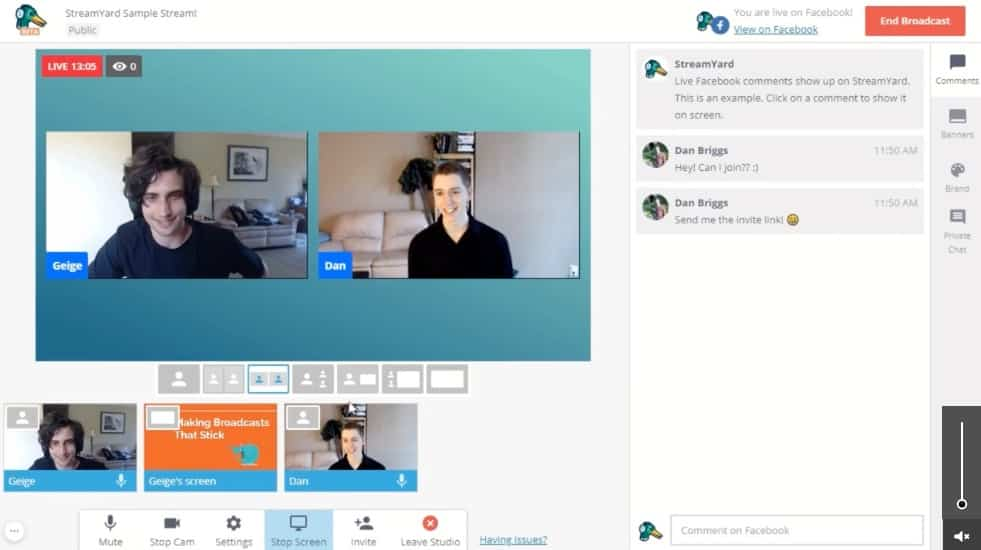

Overview and Company History:
StreamYard is a basic live streaming solution that is totally in-browser. Even though it is basic, it will get the job done for broadcasters with minimal live-streaming needs.
Since this platform is pretty simple, it is a great option for new broadcasters who are looking to pick up live streaming pretty quickly. This solution doesn’t support VOD hosting.
Basic Functionality:
StreamYard is a dedicated live streaming solution that operates entirely in the browser. It also enables you to multicast to various destinations to help you increase the reach and viewership of your live streams. This professional service also enables you to have multiple on-screen presenters if you want to host someone remotely.
Key Features:
StreamYard offers a limited range of streaming tools without any downloads necessary. The most notable features of StreamYard include its brand customization tools and ease of use.
Detailed Features:
- Brand customization
- Graphic overlays and aesthetic manipulation
- Simulcasting support
- Allows multiple on-screen presenters
- Supports screen sharing
Pros:
- Very easy to use
- Tools for engagement
- Fosters collaboration
Cons:
StreamYard is a very basic platform with minimal feature offerings. All you can do with StreamYard is live stream in-browser with multiple hosts. There is no support for VOD content, so you can’t turn your live streams into VOD content.
There are no video monetization features, so this isn’t the right platform if you want to earn money with your content. Plus, there is limited browser compatibility, so you need the right browser to use the platform.
Upload Guidelines and Specs:
StreamYard does not publish upload guidelines and specs.
Pricing:
StreamYard is a great online live-streaming solution for businesses and an easy-to-use tool for live streaming. However, due to a recent acquisition of StreamYard by Bending Spoons, the company removed its pricing from the website after a rather unpopular pricing hike around September 11, 2024.
For these reasons, we are removing any pricing information from this section until the company republishes new plans and their prices on their website.
3. Restream
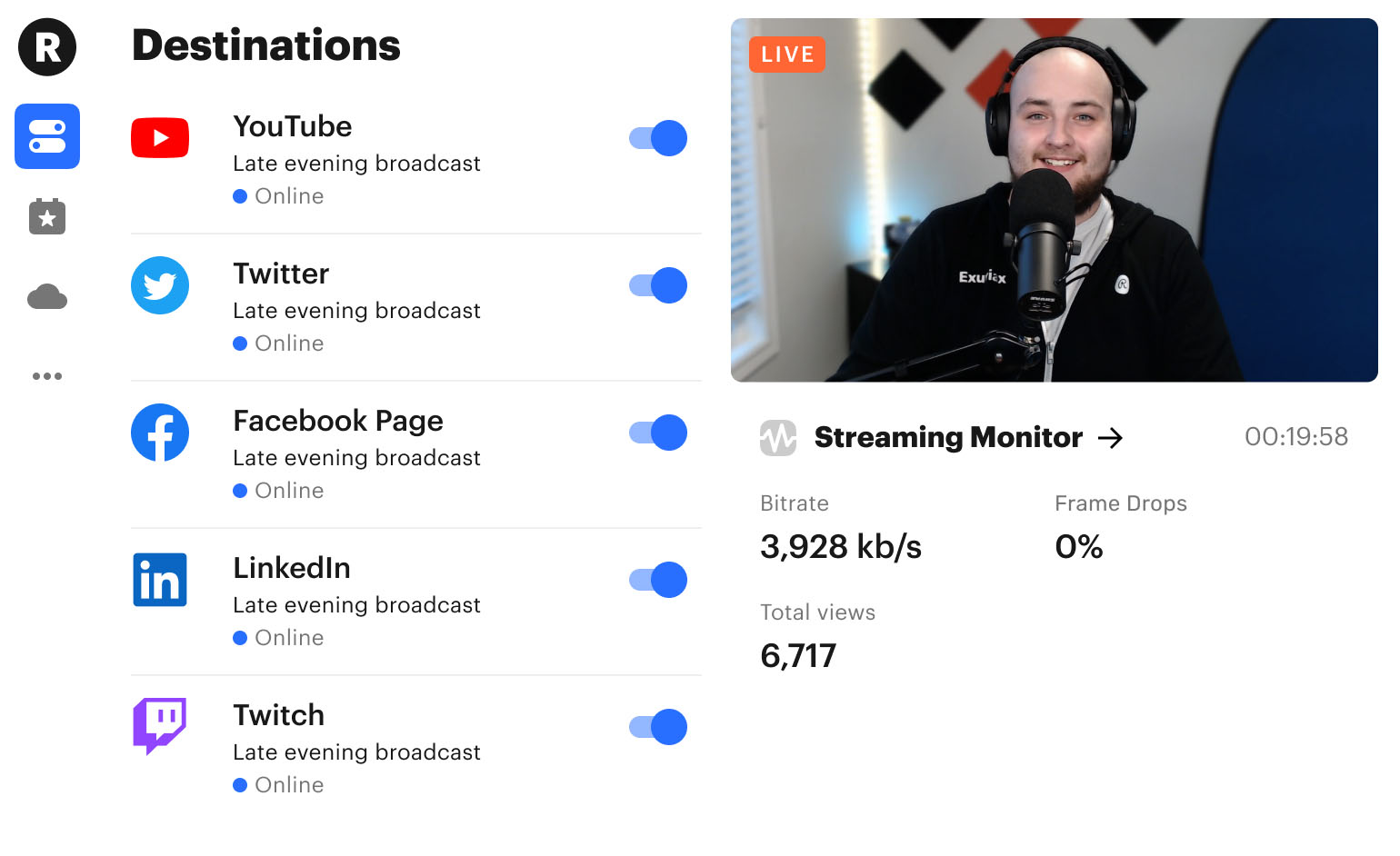

Overview and Company History:
Restream is a live-streaming solution that specializes in streaming to multiple destinations at once. However, the platform does support some other streaming products, including Restream Studio, which is their offering for in-browser live streaming.
Restream Studio offers live streaming capabilities that are designed to increase brand exposure to increase sales. This solution is relatively simple, so it is good for beginners.
Basic Functionality:
Restream is an in-browser live-streaming solution that is most popular in the gaming, tech, government, sports, media, and music industries. This service’s simulcasting feature and customizable branding options makes it a great choice for businesses that want to use it for growing their awareness. The powerful scheduling features also make it easy to inform your audience about your livestream in advance.
Key Features:
Restream is primarily a multistreaming platform, but it offers support for in-browser live streaming.
Detailed Features:
- In-browser streaming solution
- Simulcasting capabilities
- Designed to boost engagement
- Supports peer-to-peer streaming
- Customizable branding
- Event scheduling
Pros:
- Easy-to-use platform
- Support for collaboration
- Branded streaming
- Tools for interaction and engagement
Cons:
Restream is not a dedicated live streaming solution; it is a tool that allows you to live stream to multiple destinations. It isn’t the right platform for you if you need a robust video hosting solution for live streams and VOD content.
Upload Guidelines and Specs:
- Recommended dimension: 1920 ×1080
- Aspect ratio: Unavailable
- Max file size: 2GB (for pre-recorded streams)
- Max video length: 1-4 hours (depends on plan)
- Total file storage: 10 videos
- Compatible video formats: MP4, MKV, M4V, MOV
Pricing:
Restream has several pricing plans for both individuals and businesses. These include :
- Free: $0/month (for individuals) with 2-channel multistreaming
- Standard: $16/month (for individuals) with 3-channel multistreaming
- Professional: $39/month (for individuals) with 5-channel multistreaming
- Business: $199/month (for businesses) with 8-channel multistreaming
- Enterprise: Custom pricing and solutions for media and corporate teams
These prices reflect monthly rates when paid monthly, but discounts are available when you pay a full year in advance.
If you need to stream to numerous destinations at once, Restream is a good video streaming solution.
4. Resi
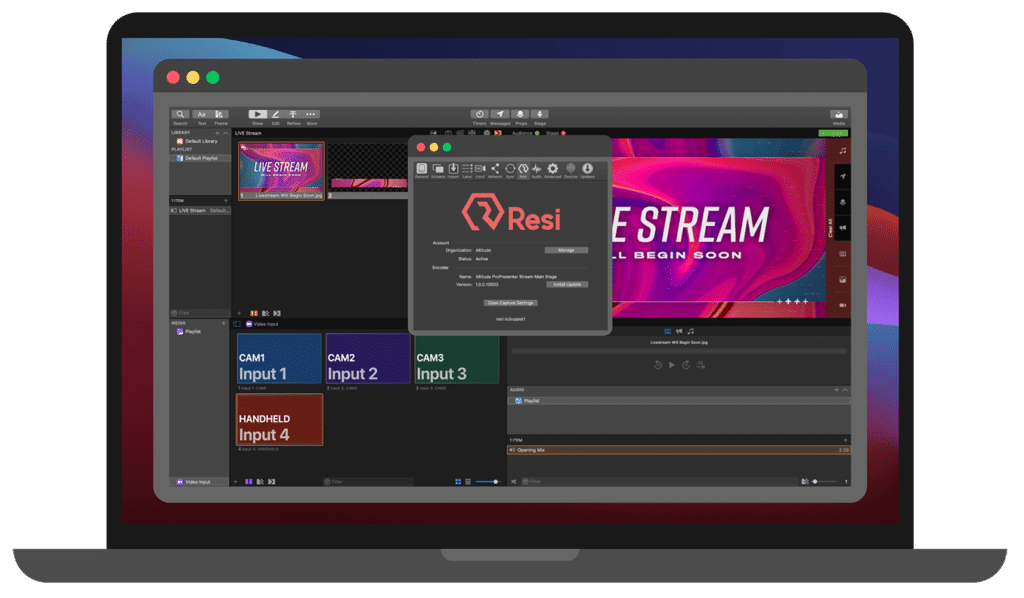

Overview and Company History:
Founded in 2014, Resi is an end-to-end live-streaming solution that is equipped with a variety of streaming tools. This company offers all of the tools that broadcasters need to get started with live streaming. In addition to live streaming services, Resi sells hardware for encoding and other related live streaming functions.
Resi is branded as an “affordable” solution, but the company does not list prices on its website.
Basic Functionality:
Resi offers a variety of live-streaming solutions and services in addition to some hardware products. You can easily simulcast your live stream to multiple destinations using RTMP. Additionally, multi-bitrate streaming features mean your audience won’t face problems while streaming. The service also offers proactive customer support so you don’t get stuck anywhere.
Key Features:
Resi offers several live streaming tools, including live stream hosting, simulcasting, and encoding technology in addition to a few hardware offerings.
Detailed Features:
- End-to-end live streaming support
- Simulcasting support
- Encoding support
- Tools for automation
- Cloud video streaming
- Activity monitoring tools
Pros:
- High-quality streaming
- Wide range of functionality
- Very trustworthy platform
- Reliable support
Cons:
- The interface on Resi is a bit outdated, making it harder to use the platform. You can use a chat function with your videos, but there are some limitations on how it works. If you want detailed video analytics, the analytic output is very simple.
Upload Guidelines and Specs:
- Minimum dimension: None
- Maximum dimension: 1920×1080
- Aspect ratio: 16:9
- Max file size: 15 GB
- Max video length: 6 hours
- Total file storage: Unavailable
- Compatible video formats: MP4
Pricing:
Interested broadcasters must fill out an inquiry form to get information on Resi’s pricing.
Resi is a solid solution if you need a live streaming solution that offers live streaming and other software solutions to help with your broadcasting needs.
5. Brightcove
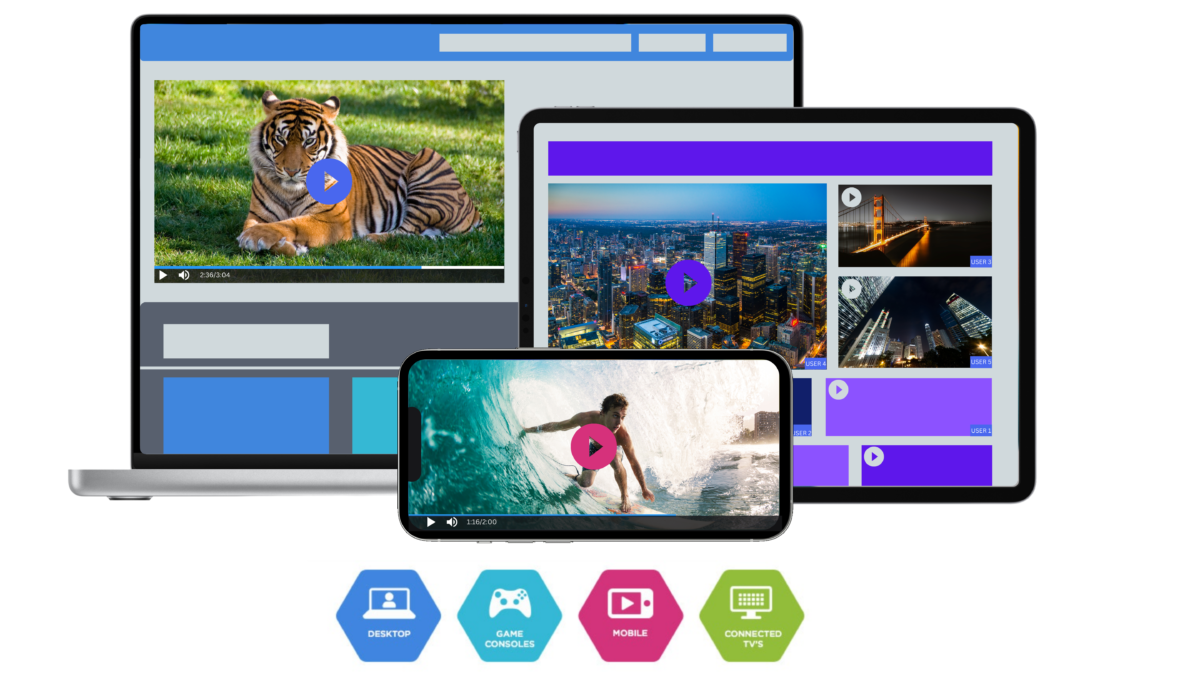

Overview and Company History:
Boston-based Brightcove was founded in 2004. It is one of the oldest online video platforms offering cloud encoding, live streaming, and VOD (video on demand) hosting. Last year, Brightcove acquired streaming platform Ooyala, known for its cloud video technology. Since the acquisition, Brightcove has announced end-of-life plans for the Ooyala OVP.
Basic Functionality:
Brightcove’s basics include video cloud hosting, the lift video player, server-side ad insertion, live streaming video, OTT flow for internet TV, encoder for cloud transcoding, and tools for monetization.
Key Features:
Brightcove’s key feature is the analytics provided to customers. Its detailed analytics and video marketing tools are quite valuable for businesses that aim to capture leads and understand their audience. What makes it perfect for OTT service providers is the fact that it allows monetization. This makes it easy to drive revenues through your livestreams – something many other livestream services don’t offer.
Detailed Features:
- Live streaming and video-on-demand hosting
- Analytics
- Server-side ad insertion
- Cloud transcoding and adaptive bitrate streaming
- Monetization options on custom-priced plans
Pros:
- Great analytics
- Custom video portals
- CRM integration
Cons:
- To use monetization options, you need to use a custom-priced plan. Plus, there is no China delivery, so if you want to livestream to China, you will need to look for a different solution.
Upload Guidelines and Specs:
- Minimum dimension: Determined by user
- Maximum dimension: Determined by user
- Aspect ratio: No restrictions (since Brightcove uses a responsive player)
- Max file size: No limits on files size
- Max video length: No published limits
- Total file storage: Varies by plan
- Compatible video formats: MP4, MOV, FLV, AVI, WMV, MKV, 3GPP
Pricing:
Brightcove’s pricing is no longer posted, but plans include basic video marketing tools and analytics with SD streaming quality for unlimited viewers. However, larger users will prefer the Enterprise communications plan, which is custom-priced. Those plans add advanced security tools, HD-quality streaming, and phone support (30-minute response time).
Marketing Studio
- Starter: Up to 10 users, CMS integrations, 12 social destinations, basic analytics, no interactivity, and Silver support.
- Essential: Adds lead form interactivity, basic encryption, e-commerce and MAP/CRM integrations, with continued Silver support.
- Premium: All Essential features plus full interactivity, Segment Sync, Tier I playback restrictions, and Gold support.
Communications Studio
- Essential: Supports multiple accounts, includes basic encryption, Silver support, standard analytics, and lead form interactivity.
- Premium: Adds full interactivity, engagement insights, Segment Sync, a Virtual Event Gallery template, and Gold support.
Media Studio
- Essential: Includes playback restrictions (geo/IP/domain/proxy/DRM), essential analytics, and SDKs for smart TVs and mobile apps.
- Premium: Adds ad insights, audience sync, offline playback, Segment Sync, interactive tools, and delivery rules.
6. StreamShark
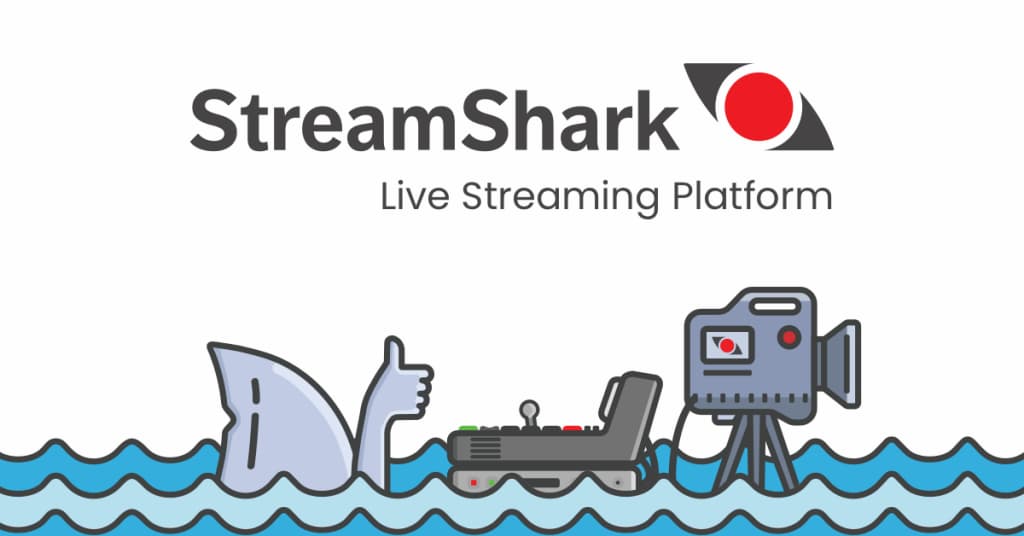

Overview and Company History:
StreamShark StreamShark is one of the top live-streaming video solutions for businesses. It was founded in 2011 and provides multi-faceted online video functionality.
Basic Functionality:
As a corporate streaming solution, StreamShark offers both a consumer-grade (B2C) platform and a distinct enterprise platform for streaming. The global reach it offers through its multi-CDN network enables you to easily boost your viewership. But the lack of China support is a bit of a drawback.
Key Features:
- Manage different phases of an event’s stream
- Multi-vendor approach
- HLS ingests
- Provides global video CDN services
- Detailed Features:
- Mobile-compatibility
- Detailed viewer reports
- Customizable live-streaming video player
- Global coverage via a multi-CDN network
- Privacy controls
- Advertising and customer support
Pros:
- Localized media ingestion
- Monetization options
- Video Encoding
- Redistribution
- Increased storage space
Cons:
- Streamshark doesn’t offer live support, so if you have an issue, you will have to troubleshoot it yourself or submit a support request via their online form.
- They don’t offer embeddable playlists, making it difficult to keep viewers engaged and watching more of your content.
- Their video analytics are basic and don’t offer much insight.
- They don’t offer China live streaming support.
Upload Guidelines and Specs:
- Minimum dimension: 240p (426 x 240)
- Maximum dimension: 1080p (1920 x 1080)
- Aspect ratio: 16:9, 4:3
- Max file size: not available
- Max video length: not available
- Total file storage: 500GB, 1TB, 3TB
- Compatible video formats: HLS, WebM VP9, WebM VP8, WebM VP9 DASH, MP4
Pricing:
Monthly live streaming plans with StreamShark begin at $199 per month and include the following:
- Standard: $199/month; includes 1,000 GB of bandwidth; overage charges of $0.10/GB
- Team: $499/month; includes 4,000 GB of bandwidth; overage charges of $0.09/GB
- Business: $999/month; includes 9,000 GB of bandwidth; overage charges of $0.08/GB
- Enterprise: Please contact StreamShark for their custom enterprise solutions and plans
StreamShark has both consumer-grade and enterprise-grade platform offerings, allowing your business to grow with access to more advanced tools when you need them.
7. IBM Cloud Video (formerly UStream)
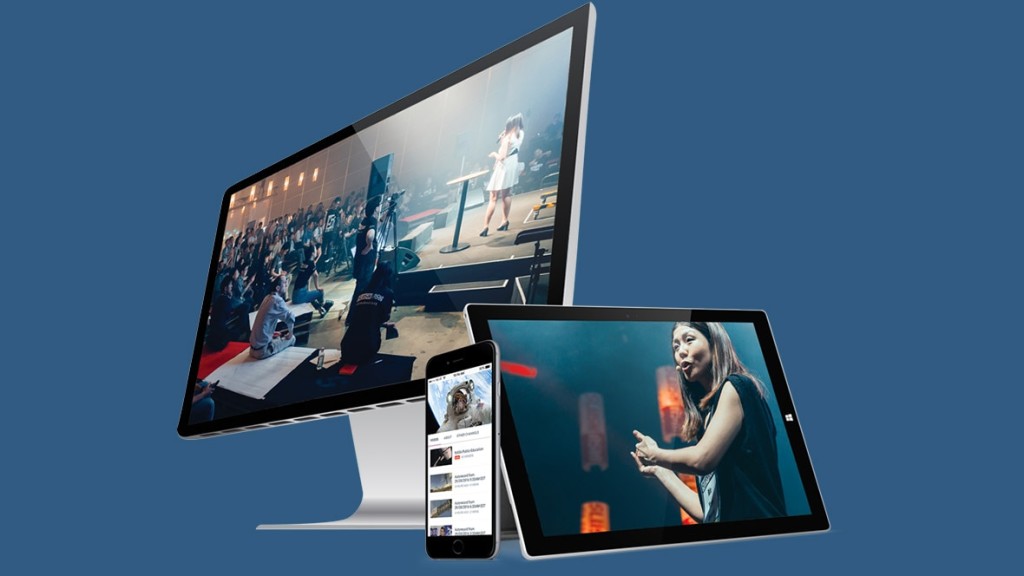

Overview and Company History:
Next in our live video streaming solutions review, IBM Cloud Video is the platform formerly known as UStream. This platform offers video hosting and cloud video streaming solutions, as well as a variety of features. Founded in 2007 to connect military service members with family, IBM purchased UStream in 2016.
Basic Functionality:
The basic functionality of IBM is live streaming. However, this live-streaming solution also hosts video-on-demand files from previous live streams.
Basic streaming accounts are free, with advertising supporting IBM Cloud Video. Paid accounts remove advertising and grant access to advanced features. Enterprise accounts allow for full custom branding and offer analytics, multiple live channels, content syndication, and more.
Key Features:
Overall, the key elements of the IBM Cloud Live Video solution include:
- Streaming up to 720p resolution (*only Enterprise plans support 1080p full HD streaming)
- Mobile-compatible video player
- White-label custom branding (with high-end plans)
- Uses IBM internal CDN to distribute content
- API available (with high-end plans)
- Detailed Features:
- Video distribution and workflow
- OTT video management
- Enterprise video streaming
- Enterprise content delivery network
- Monetization capabilities
Pros:
- Reliable platform
- Perfect for larger clients
- Good customer support
- Wide range of features for broadcasters
- Hong Kong (China) video hosting
Cons:
- To stream content above 720p resolution, you’ll need to pay extra fees.
- If providing closed captioning for your live streams is essential, be aware that their closed captioning support is limited.
Upload Guidelines and Specs:
- Minimum dimension: 480p (480 x 270)
- Maximum dimension: 4K (3840 x 2160)
- Aspect ratio: No published aspect ratio
- Max file size: 4 GB
- Max video length: No published limits
- Total file storage: 1TB – 5TB (depends on plan)
- Compatible video formats: MKV, MP4, MOV, FLV, AVI, WMV, MPEG2, H264, H263, MPEG4, VP6, VP8, THEORA, WMV, MP3, AAC-LC, NELLYMOSER, PCM, SPEEX, VORBIS, WMA
Pricing:
The pricing plans for the IBM Cloud Video include:
- Start Trial – Video Streaming: Give it a free test drive for 30 days
- Silver: Affordable Essentials, 100 viewer hours, 5 channels, 1 TB video storage, starting at $145/month
- Gold: Standard business features, 2,000 viewer hours, 10 channels, 2 TB video storage, starting at $729/month
- Platinum: Premium Volume scale, 5,000 viewer hours, 20 channels, 5 TB video storage, starting at $1,460/month
- Custom: Please contact IBM Cloud video for custom plan pricing as well as payment plans
IBM Video Streaming also offers an SaaS streaming service with AI-driven deep search for security-rich video communications. Here are the IBM Enterprise Video Streaming pricing plans:
- Enterprise Silver: $847/month
- Enterprise Gold: $2,120/month
- Enterprise Platinum: $5,300/month
- Custom: Contact the sales team
30-day free trials are available for test-driving both the IBM Video Streaming and the IBM Enterprise Video Streaming services.
8. Cincopa
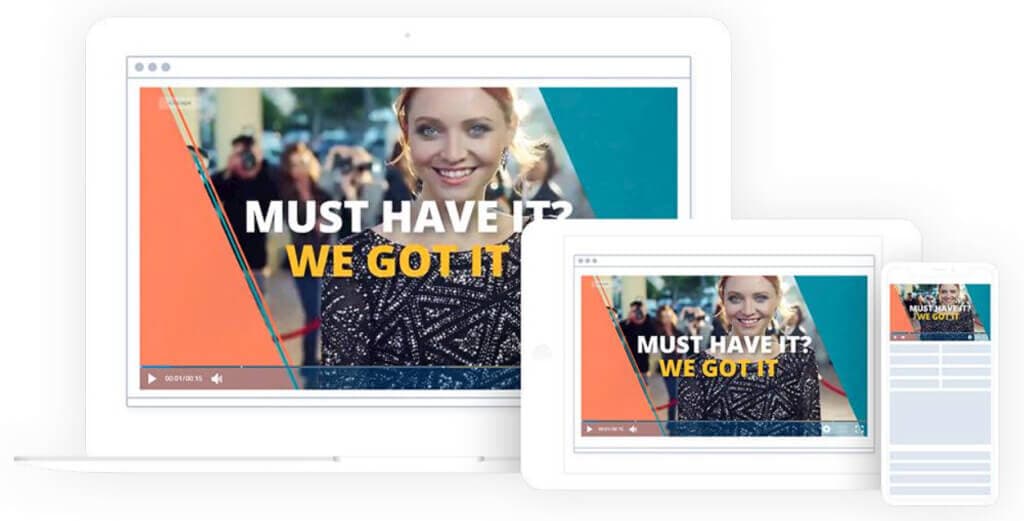

Overview and Company History:
Cincopa is a multimedia hosting platform that large organizations use to store their content. In addition to media hosting, Cincopa offers all of the tools that broadcasters need to host high-quality live streams.
Cincopa offers plans for different budgets. The range of pricing offerings paired with the flexible functionality of this platform makes it a great tool for many different kinds of broadcasters.
Basic Functionality:
Cincopa is a multimedia video hosting platform that is capable of digital content management and hosting of video, audio (podcasts and music), photos, and more. However, this platform also supports live streaming.
Key Features:
Cincopa provides all of the features that broadcasters need for a professional streaming experience, including video monetization, stream recording, OTT streaming, powerful content delivery, and more.
Another perk of this live-streaming platform is that it supports integrations for a customizable streaming experience.
Detailed Features:
- Multimedia video hosting
- Live streaming support
- Powerful video player
- Reliable customer support
- Integrations for customization
- OTT streaming
- Reliable CDN partnerships
- Secure streaming
Pros:
- High-quality, professional streaming experience
- Video monetization
- Tools or businesses with large multimedia storage/hosting needs
- Solutions for sales, marketing, education, production, publishing, and more
- Customizable streaming
- Video analytics
Cons:
- Cincopa is a multi-media hosting service; live streaming is a secondary offering. That means they don’t have all the bells and whistles that a service offering live streaming as their focus would offer.
- There are some media storage limits you could run into if you have lots of content.
Upload Guidelines and Specs:
- Minimum dimension: 144p
- Maximum dimension: 4K
- Aspect ratio: 4:3, 16:9
- Max file size: 1, 2, 20GB (depending on the plan)
- Max video length: not available
- Total file storage: 5 videos, 40 videos, unlimited videos (depending on the plan)
- Compatible video formats: AVI, MOV, WMV, MP4, M4A, F4A, F4B, F4V, F4P, M2TS, MTS, VOB, MKV, RMVB, M1V, QT, DIV, DIVX, DV, 3GP, 3GPP, 3G2, MPG, MPEG, MPE, FLV
Pricing:
Cincopa offers four pricing plans for multimedia hosting:
- Plus: $25/month; 50 videos, 75 audio/podcast files, 1 TB monthly traffic
- Corporate: $99/month; 250 videos, 300 audio/podcast files, 2 TB monthly traffic
- Enterprise: $350/month; unlimited videos, audio/podcast files, and monthly traffic
- Custom Enterprise: Custom pricing; dedicated account manager, SSO
Please check out Cincopa’s pricing page for a further breakdown of storage and capabilities that come with each plan. You can start with a 30-day Corporate plan trial anytime.
Cincopa is a professional-grade live streaming solution that allows for monetization, as well as storage for audio and visual files.
9. JW Player
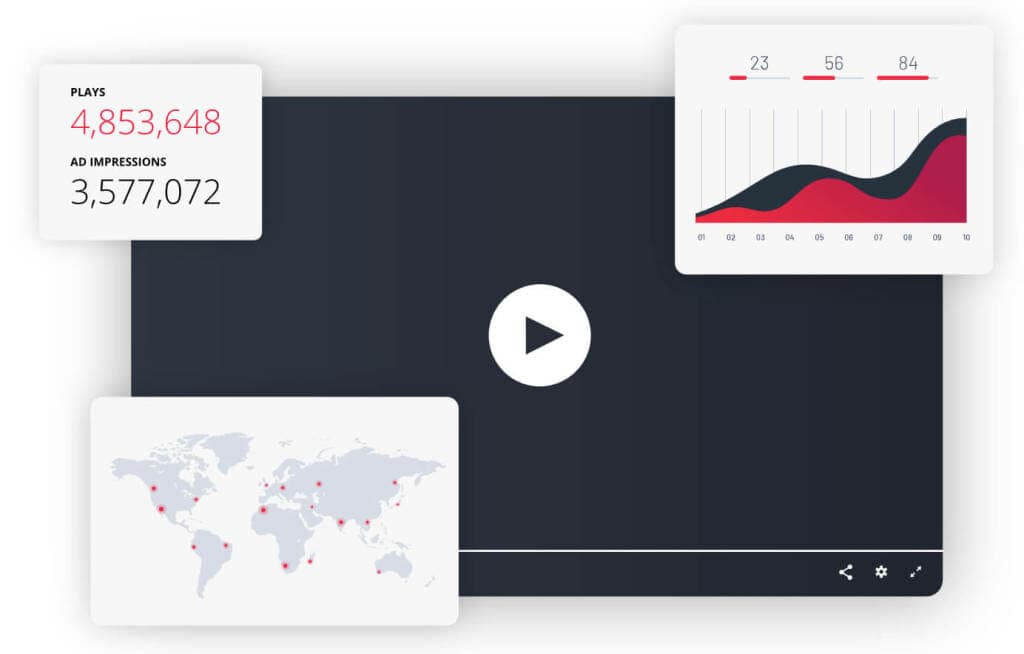

Overview and Company History:
The JW Player project (as the name suggests) began as a video player. This now streaming solution was founded in 2005 as part of a student project. Today, this service offers video hosting services and live streaming.
Basic Functionality:
This solution is known for its HTML5 video player for VOD content. In addition to that, JW Player is now a full-service live-streaming provider. It gives you global delivery of your live-streaming video content and also makes it easy to monetize the content so you can drive your revenues with it as well.
Key Features:
- Live streaming and video-on-demand (VOD) hosting
- Video recommendations engine to generate custom “watch next” recommendations
- Tools for monetization via advertising and detailed revenue tracking
- Analytics tools
Detailed Features:
- Multi-bitrate and adaptive streaming
- Global content delivery
- Email support through the $100/month plan level
- Video API access on all plans
- Security features are basic but functional.
- Only custom-priced Enterprise plans offer DRM
- Monetization via advertising
Pros:
- Great video player
- Simple, easy-to-use platform
- Good advertising tools
Cons:
- Some users report that support can be slow or less responsive, particularly for those on lower-tier plans.
- For new users or those without technical experience, there can be a bit of a learning curve
- There is no China live stream video delivery.
Upload Guidelines and Specs:
- Minimum dimension: 360p (640 x 360)
- Maximum dimension: 1080p (1920 x 1080)
- Aspect ratio: 16:9, 4:3, 2.39:1
- Max file size: 25GB
- Max video length: Not available
- Total file storage: 25GB to 500GB (depending on the plan)
- Compatible video formats: MP4, WMV, AVI, MOV, 3GP, FLV
Pricing:
JWPlayer pricing is custom. The pricing details are not available and you need to get in touch with their team with your requirements to get a customized quote.
JW Player is a simple live-streaming solution platform that is easy to use if you are a beginning broadcaster or are not that much of a techie.
10. Kaltura
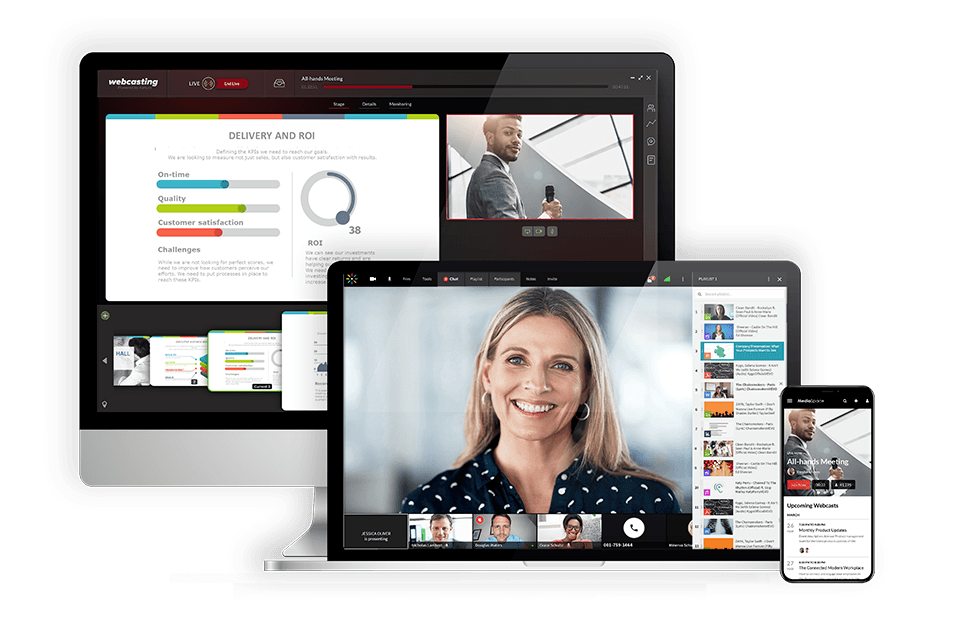

Overview and Company History:
The Kaltura online video platform targets large institutions. In particular, Kaltura focuses on four markets: video services for educational institutions, enterprises, media companies, and OTT video services. Historically, this company has worked most extensively with educational institutions.
Basic Functionality:
This video streaming solution is an alternative to the self-hosted model. The software for Kaltura is free, however, it requires an infrastructure of servers for hosting and distributing content.
Kaltura provides cloud-based video hosting and distribution for both VOD and live streams. You also get advanced features like adaptive bitrate streaming that enable viewers to watch your videos even with low network speeds. The ability to add your own CDN is a great approach as you can greatly influence the quality of the stream with it.
Key Features:
The Kaltura Management Console (KMC) offers tools to create, upload, edit, manage, publish, and deliver live and on-demand video to viewers. Key features of the KMC include:
- Live streaming and VOD hosting
- Secure content delivery via Akamai, Limelight, and eCDNs
- Live transcoding, live production software, and video marketing tools
- Video APIs, SDKs, developer tools, and code recipes
- A highly customizable, and, therefore highly complex streaming platform
Detailed Features:
- Multi-bitrate and adaptive streaming
- Video API access
- Global content delivery via a combined CDN approach
- Ability to bring your own CDN
- Security features include a range of authentication and encryption options
- Monetization includes all major models – subscription, advertising, PPV streaming
Pros:
- Many available features
- Totally customizable streaming experience
- Great monetization options
- Robust security
Cons:
- Kaltura has lots of features, but it can be highly complex to operate and learn how to use. It is not suited for new broadcasters.
- They have a ticket-based system for support, so it can take a while to get the help you need.
Upload Guidelines and Specs:
- Minimum dimension: 180p (320 x 180)
- Maximum dimension: 1080p (1920 x 1080)
- Aspect ratio: 16:9, 4:3
- Max file size: 2GB
- Max video length: Not available
- Total file storage: 10GB to Unlimited (depends on the plan)
- Compatible video formats: MOV, MP4
Pricing:
Prices are based on the solutions you’re looking for. These billed monthly plans include:
- Business: $199/month (or $150/month when billed annually)
- Enterprise: Custom pricing
- Free trial: 14 days;
- Basic: $19/month (or $17/month when billed annually); up to 8 participants per session and 8 hrs of cloud recording
- Pro: $55/month (or $50/month when billed annually); up to 25 participants per session and 15 hrs of cloud recording
- Business: $125/month (or $115/month when billed annually); up to 100 participants per session and up to 25 hrs of cloud recording
- Business Plus: Custom pricing for up to 300 participants per session, unlimited sessions and custom storage needs
- Annual discounts: Discounted pricing packages available for any scale and use-case, enterprise SLA, and developer support
- Limited trial account: $1 for $100 worth of credits for 30 days for testing and experimentation, with no commitments
- Pay as you go – You pay only for what you use at these credit levels:
- Base plan: $20 one-time annual fee + monthly usage fees
Other services include virtual events, video portal town halls, video messaging, meetings, and more.
11. Muvi
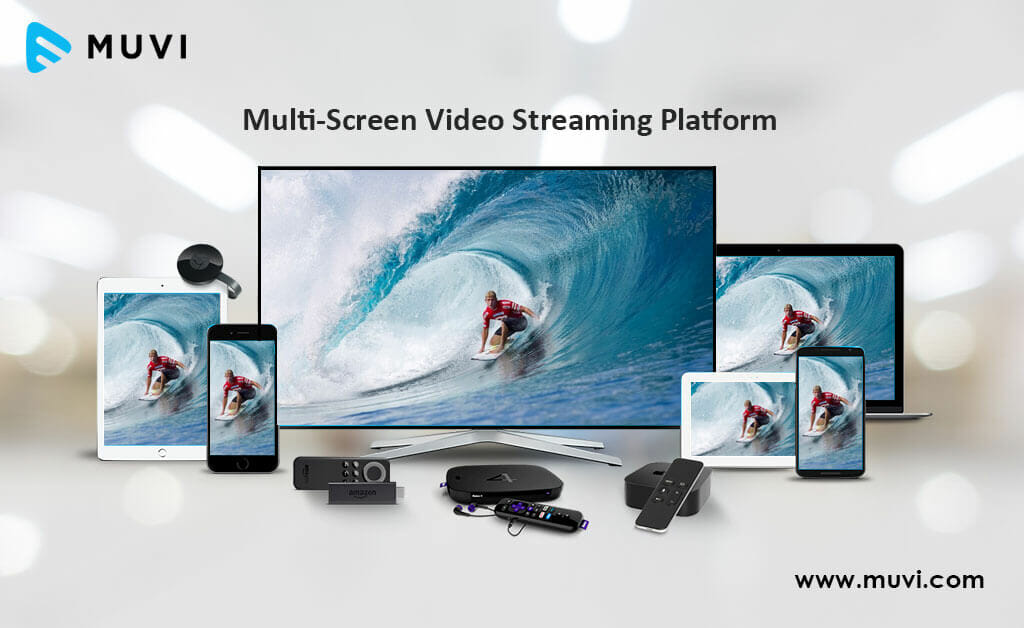

Overview and Company History:
Moving along in our live video streaming solutions review, let’s consider Muvi. This corporate video streaming solution centers on OTT media businesses. Overall, Muvi aims to provide a “turnkey” service to broadcasters.
In short, Muvi focuses on OTT services that are quick to get up and running. They say their model empowers users to launch their own video or audio strategy quickly and easily.
Basic Functionality:
Muvi’s OTT multi-screen video streaming solution helps businesses launch white-label multi-device streams. They also provide VOD and audio streaming. It’s fully managed and all controlled from a single CMS.
The monetization options offered by this professional streaming service mean that you can easily use the live streams to drive your revenues. Also, the detailed analytics combined with digital rights management mean that your livestreams will always be secure.
Key Features:
- HTML5 all-device video player
- White label custom branding
- Various monetization options
- Support for video and audio streaming
- Dashboard management CMS for naming and organizing content
- 24/7 support
Detailed Features:
- Custom branding
- HTML5 video player
- Analytics
- Monetization options
- DRM and security features
Pros:
- CDN delivery
- Hosting
- No coding required
- Video CMS
- Transcoding
- DRM
- Website and Apps for Mobile and TV
Cons:
- Muvi’s setup process can be complex, especially for more advanced features
- it can be difficult for beginners to navigate if you don’t have experience with video streaming solutions.
Upload Guidelines and Specs:
- Minimum dimension: 144p (256 x 144)
- Maximum dimension: 4K (3840 x2160)
- Aspect ratio: 16:9, 4:3
- Max file size: not available
- Max video length: not available
- Total file storage: 1TB, 2TB, 5TB (depending on plan)
- Compatible video formats: MP4, MOV, MKV, FLV, VOB, M4V, AVI, 3GP, MPG
Pricing:
Muvi has a very wide spectrum of pricing plans divided in 7 categories, namely One, Live, Flex, Player SDK, Playout, TV, and Alie.
The pricing for the Muvi One category includes the following plans:
- Standard: $399/month
- Professional: $1,499/month
- Enterprise: $3,900/month
- Ultimate: Contact sales for price
Each plan has different features, such as the number of concurrent users, hosting options, and add-ons like the Alie recommendation engine.
The pricing breakdown for the Muvi Live plans is as followed:
- Standard: $99/month
- Professional: $299/month
- Enterprise: $799/month
If you need to quickly set up a video hosting service, Muvi is designed to provide you with a turn-key streaming solution.
12. Panopto
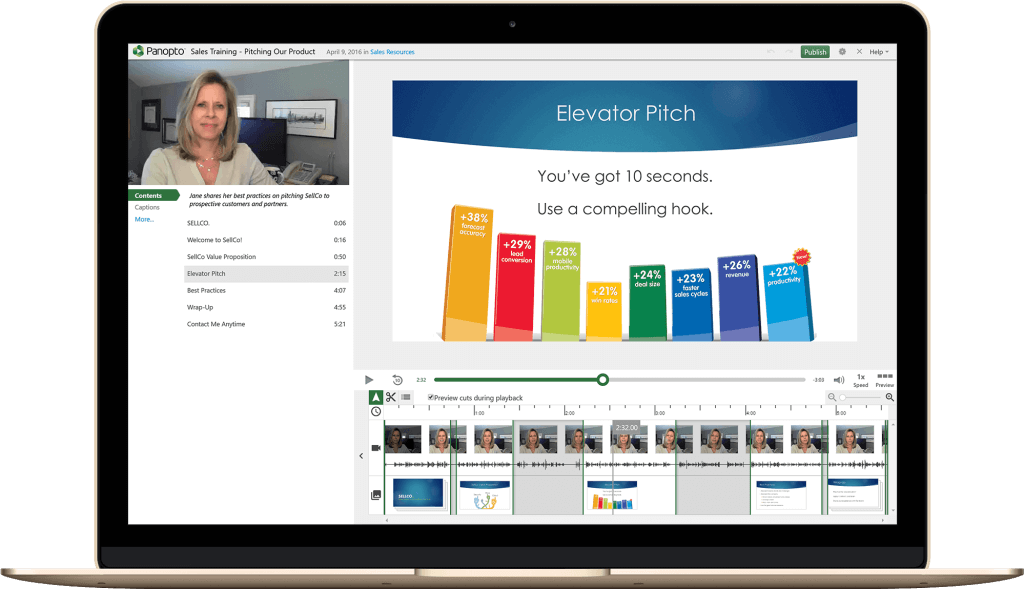

Overview and Company History:
Company Background:
Panopto is one of the live video streaming solutions aimed at educational and institutional users. This platform aims to deliver an “internal YouTube” experience for training and more. It was founded in 2007 in Pittsburg at Carnegie Mellon University as a tech project. This online video streaming solution enables streaming, sharing, recording, and managing of video content.
Panopto has more than 100 employees in 6 offices around the world. This streaming solution serves an audience of over 5 million end-users in the e-learning space.
Basic Functionality:
With a focus on online education, it provides tools similar to YouTube and integrates with Learning Management Systems. Overall, Panopto is a more focused online video organization than the other top live streaming solutions considered here.
Key Features:
- Secure portal for management
- Includes software for live streaming and auto-archiving using webcams
- Keyword search inside videos
- Tools for API access and LMS/CMS integration
Detailed Features:
- Lecture-capture and video-search software
- Access control & security features
- White-label streaming
- Integration with LMS systems
- APIs for further integrations.
Pros:
- Audio Content
- Analytics
- Document Indexing
- Customizable Branding
- Full-Text Search
- Video Content
- Asset Categorization
- China video delivery
Cons:
- Panopto lacks extensive options for template customization or advanced design editing
- New users may find the interface and features a bit complex, particularly when it comes to advanced video management and analytics.
Upload Guidelines and Specs:
- Compatible video formats: AVI, MP4, MPG, WMV, MOV, QT, ASF, 3GP, WMA, MP3, M4V
- All other upload guidelines and specs are only available to paying customers.
Pricing:
Panopto recently simplified its pricing packages and it offers a free demo and trial of these packages. However, for pricing details, you need to get in touch with their team with your requirements.
Panopto is a great video streaming solution for those in the educational sector. It is a simpler solution for educational enterprises.
13. Vimeo


Overview and Company History:
Vimeo is a popular video hosting and live streaming platform launched in 2004. Initially focused on creative professionals, Vimeo has evolved into a comprehensive tool for video hosting, editing, and live streaming.
In 2017, Vimeo acquired Livestream and integrated its live streaming features. As of January 2025, Livestream has been fully merged into Vimeo. Known for its high-quality, ad-free experience, Vimeo is used by creators and businesses for professional video production and live streaming.
Basic Functionality:
A solid streaming alternative, Vimeo offers live broadcasting as well as video hosting services. The services include analytics and a video management platform.
Key Features:
- Full-HD quality
- All-device video player with adaptive bitrate streaming
- Privacy tools, or embed to any website
- White-label service
- Live audience chat
- Monetization options
Detailed Features:
- Large storage capacity
- Privacy options
- Video management service
- High-quality videos and streams
- Upload from anywhere
Pros:
- Unlimited events and viewers
- No ads
- Sleek and professional appearance
- Thoroughly detailed analytics
- Easy to use
- Pay-per-view option
Cons:
- There is no China video delivery.
Upload Guidelines and Specs:
- Recommended dimension: 720p (1280 x 720)
- Aspect ratio: 16:9, 4:3
- Max file size: 3GB
- Max video length: Information not available
- Total file storage: Information not available
- Compatible video formats: MP4 (recommended)
Pricing:
Vimeo offers basic video hosting plans that are suitable for content creators and startups. Pricing if billed monthly, is as follows:
- Free: $0/month; 1 GB storage, creation and editing, screen recording
- Starter: $20/month; 100 GB storage, auto closed captioning, custom URLs and video player, privacy tools
- Standard: $41/month; 2 TB storage, engagement and social analytics, AI script generator, teleprompter, brand kit
- Advanced: $125/month; 7 TB storage, stream to multiple destinations, host live broadcasts and webinars, AI-generated chapters and text summaries
- Enterprise: Custom pricing; more storage and bandwidth, advanced AI capabilities, quality events, dedicated support
Vimeo is great if you want to maximize the usage of your content by turning your live streams into VOD content.
Vimeo OTT Pricing:
Vimeo’s OTT solution is priced separately from the regular Vimeo packages. There are two plans: Starter and Enterprise.
- Starter Pricing: $1/subscriber per month (or 10% of one-time purchases)
- Enterprise Pricing: Contact sales
This OTT-specific pricing package comes with the Vimeo.com relationship. These plans include all the basics for starting your web-based OTT channel, as well as growing your OTT business online.
For more details, check out our comprehensive guide to Vimeo Livestream pricing.
If you need a video streaming solution that supports large viewership, Vimeo is a great option.
14. Wowza
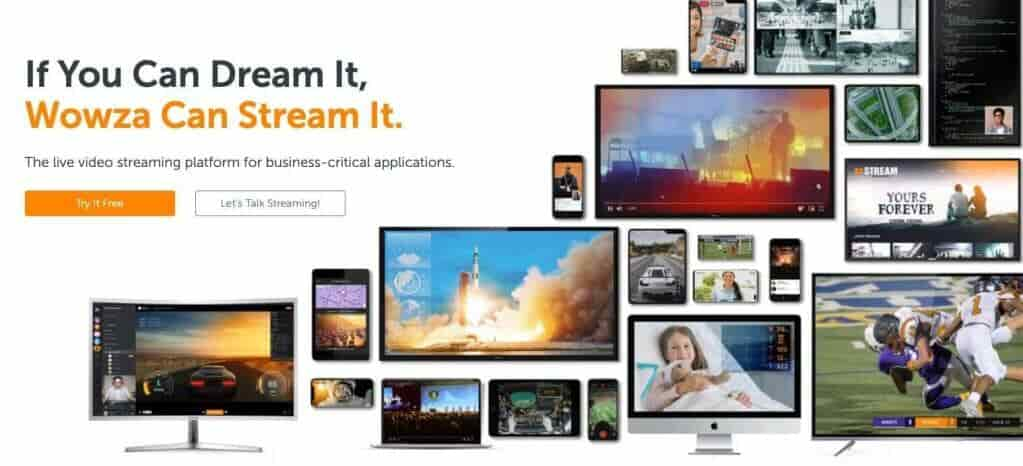

Overview and Company History:
The next live video streaming solution that we will review here is Wowza Streaming Cloud. Wowza is feature-rich and provides a customizable platform for broadcasters of all sorts. It was founded in 2005 by David Stubenvoll and Charlie Good. Wowza is a bootstrap start-up with live and on-demand live-streaming capabilities.
Basic Functionality:
Wowza offers two main products. The first is the Wowza Streaming Engine. This product is widely used in the industry for self-hosted streaming. The second is the Wowza Streaming Cloud offering. This functionality includes a variety of features aimed at providing low-latency content access to global audiences.
Key Features:
- Live streaming and on-demand video hosting
- Host-you-own streaming server product
- White-label streaming
- Mobile-compatible video player
- Customer support (*note that phone support and fast responses cost extra)
- RESTful API available
Detailed Features:
- APIs are available
- Live stream recording
- Cloud management portal
- Streaming up to 4K
- Wide range of security options
Pros:
- Audience Engagement
- Performance Monitoring
- Mobile Screen Support
- Robust security
- Video Streaming
- Video Looping
- China video delivery
Cons:
- Wowza has a lot of drawbacks to consider if you want to use it for live streaming. It doesn’t offer any tools or support for multistreaming, limiting your ability to connect with viewers on other platforms.
- They don’t offer session recording, so you can’t turn your live content into VOD. There are no video monetization tools, so if making money directly from your live content is your aim, this isn’t the platform for you.
- There are no event scheduling or countdown features, so when you go live, you just go live. This can make it difficult to build an audience. It also lacks audience analytics.
Upload Guidelines and Specs:
- Minimum dimension: 240p (320 x 240)
- Maximum dimension: 4K (3840 x 2160)
- Aspect ratio: 16:9, 4:3
- Max file size: Not available
- Max video length: Not available
- Total file storage: 250 GB (depends on the plan)
- Compatible video formats: MP4, FLV, MP3, SMIL, AMLST, ID3, NGRP
Pricing:
Wowza recently overhauled its pricing plans and added several options. These are split into 2 main tiers: Wowza Video and Wowza Streaming Engine
The Wowza Video Cloud Streaming offers four distinct pricing plans and services.
- One Month of Streaming: $149 one-time purchase; includes 15 hours of live streaming and 500 viewing hours
- Pay as you go: $0/month; $2.50/hour of streaming, all usage billed separately
- Enterprise: Annual plans built for your needs; contact sales for custom pricing
The Wowza Streaming Engine has its own pricing plan packages. These professional-grade streaming plans are billed annually and include:
- One Month of Streaming: $295/month one-time purchase
- Basic monthly: $195 per month
- Enterprise: Please contact Wowza directly for access to their custom-tailored high-volume enterprise solutions
Check out Wowza’s pricing page for alternative plans and packages.
If you need a budget-friendly video hosting platform with streaming security, try Wowza.
15. Vidyard


Overview and Company History:
Vidyard is a video hosting and live-streaming platform designed primarily for businesses. Founded in 2010, the platform is known for its focus on marketing, sales, and corporate communications. It provides tools that enable businesses to create, manage, and analyze video content while integrating with various CRM and marketing automation tools.
Basic Functionality:
Vidyard offers live streaming alongside video hosting and marketing tools. It is built to help businesses generate leads, engage customers, and track video performance.
Key Features:
- Live streaming with real-time analytics
- CRM and email marketing integrations
- Video personalization tools
- Secure video-sharing options
- Lead generation features
Detailed Features:
- Interactive video elements (CTAs, forms, etc.)
- Custom branding and white-labeling
- AI-powered video analytics
- Password protection and access control
- Video SEO tools
Pros:
- Strong integration with marketing platforms
- Detailed video analytics
- High level of customization
- Lead capture capabilities
Cons:
- Live streaming is only available on higher-tier plans
- More focused on business applications than general streaming
Upload Guidelines and Specs:
- Recommended dimension: 1080p (1920 x 1080)
- Aspect ratio: 16:9
- Max file size: 5GB
- Max video length: No set limit
- Compatible video formats: MP4 (recommended)
Pricing:
Vidyard offers multiple pricing tiers:
- Free Plan: $0
- Starter: $59/month; team performance analytics, password-protected videos, and customizable branding
- Teams: $99/month; everything in Starter + CRM/MAP integrations for seamless workflows, folder management, video captions, and advanced analytics
- Enterprise: Custom pricing; AI avatars, SSO user management and secure playback, unlimited integrations, custom permissions and security options
Vidyard is an excellent solution for businesses looking for an integrated live streaming and video marketing tool.
16. VPlayed


Overview and Company History:
VPlayed is a fully customizable, white-label OTT streaming platform designed for businesses, broadcasters, and content creators. Developed by Contus, this platform offers secure live streaming and VOD hosting with monetization features.
Basic Functionality:
VPlayed provides a complete live-streaming and on-demand video solution with a focus on customization, security, and monetization.
Key Features:
- Multi-device live streaming
- White-label customization
- Multiple monetization models (AVOD, SVOD, TVOD)
- DRM security and encryption
- Adaptive bitrate streaming
Detailed Features:
- 100% customizable streaming solution
- Multi-CDN for global delivery
- AI-powered content recommendations
- API-based integrations
- Cloud-based storage and delivery
Pros:
- High level of customization
- Secure content delivery
- Multiple revenue-generating options
- Scalable solution
Cons:
- No free tier
- Pricing can be high for small businesses
Upload Guidelines and Specs:
- Recommended dimension: 1080p (1920 x 1080)
- Aspect ratio: 16:9
- Max file size: Varies by plan
- Max video length: No limit
- Compatible video formats: MP4, MOV, AVI
Pricing:
VPlayed follows a custom pricing model based on features and business needs. Interested users must contact their sales team for a quote.
VPlayed is a great option for businesses and broadcasters looking for a fully customizable, enterprise-grade streaming solution.
Top Social Streaming Solutions
Social media streaming apps like YouTube Live and Facebook Live are not capable of video hosting on a professional level. However, they are useful for promoting content on your website, connecting with your audience, and building a loyal following for your brand.
Here are a few of the top social media platforms for live streaming and video sharing.
17. LinkedIn Live


Overview and Company History:
LinkedIn is a popular social media platform that was designed for professionals to network and connect. This platform recently rolled out LinkedIn Live, a premier business offering that helps brands connect with professionals through live-streamed content. This feature is accessible on an application basis.
LinkedIn Live requires the support of a custom RTMP stream setup (self-hosted) or the support of a third-party streaming platform (like Dacast and many of the other tools we’ve mentioned above).
The value of streaming with LinkedIn Live is that it is possible to target a very specific audience: professionals in your industry. That said, this platform is best-suited for broadcasters with the goal of connecting with a niche audience.
Basic Functionality:
LinkedIn Live is a newly added feature for enhanced engagement on this professional social media platform.
Key Features:
LinkedIn Live is a highly regulated feature that allows brands to connect with professionals in their industry.
Detailed Features:
- Simple streaming to a professional audience
- Highly regulated
- Quality-control and exclusivity
- Designed to boost engagement
- Integrated with LinkedIn Events for virtual event hosting
Pros:
- Not a professional streaming solution
- Free to use
- Very specific audience
- Built to increase brand awareness
- Boosts engagement among an audience
Cons:
LinkedIn live requires a third-party video hosting service to use the platform. There are lots of restrictions and guidelines for streaming. Plus, you need to apply for access.
Upload Guidelines and Specs:
Video guidelines and specs depend on the third-party app that you use for support.
Pricing:
LinkedIn Live is free to use as long as LinkedIn accepts your application. LinkedIn Live is a good way to reach a professional audience.
16. Twitch


Overview and Company History:
Twitch is a very popular application in the world of video gaming. Streamers set up channels where viewers and supporters can follow them.
This site is pretty niche, but it is a great streaming platform if you are trying to reach an audience in the gaming, fantasy, or tech industry.
Basic Functionality:
Twitch is a consumer-grade platform for independent streamers, and it is especially popular among video game streamers.
Key Features:
Twitch is a social network that is primarily meant for Esport streaming.
Detailed Features:
- Tools for tipping
- Primarily used to stream video games
- Live chat for viewer engagement
Pros:
- Tools to promote user engagement
- Easy to share on social media channels
Cons:
- Twitch doesn’t offer privacy features or protection for your content.
- The platform has strict community guidelines.
- You can’t apply any outside monetization features; you have to earn privileges to make money on the platform and become a member of their partner program.
Upload Guidelines and Specs:
- Minimum dimension: 720p (1280 x 720)
- Maximum dimension: 1080p (1920 x 1080)
- Aspect ratio: 16:9, 4:3
- Max file size: Not available
- Max video length: 48 hours
- Total file storage: Not available
- Compatible video formats: MP4, MOV, AVI, FLV
Pricing:
Twitch is free to use.
Twitch is a great video streaming solution, especially if you are in the gaming industry.
17. YouTube Live
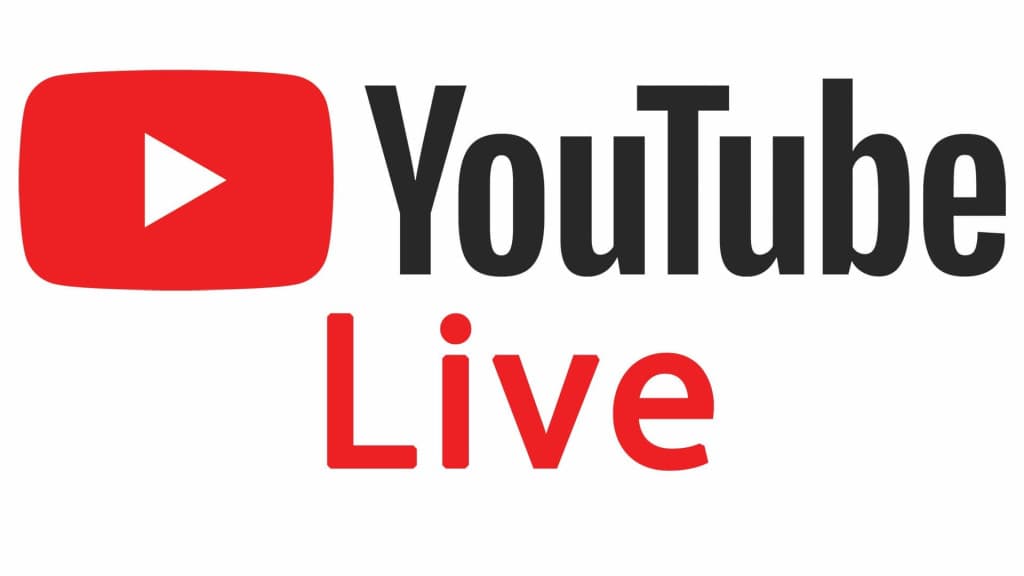

Overview and Company History:
YouTube YouTube was one of the first websites that made online video streaming so popular. It has grown exponentially in the past decade. This Google-owned platform is designed for consumers and independent content creators, but many businesses use it while they are getting into broadcasting since it is free and easy to use.
YouTube is not ideal for business use since the site has strict limitations on the type of content that you can post. Additionally, there is limited access to monetization and other professional tools.
One of the biggest turn-offs for professional broadcasters is that YouTube requires users to give up partial ownership of their content when they upload it to the platform.
Basic Functionality:
YouTube Live is a free B2C video streaming platform designed for users with little to no prior broadcasting experience.
Key Features:
YouTube Live is a consumer-grade video-sharing platform that supports both VOD and live streaming. The most popular type of content on the platform is on-demand videos.
Detailed Features:
- Ad-based monetization (with strict limitations)
- No reliable security features
- Popular among consumers
- Owned by Google
- Easy to share videos
- Videos can be embedded in other websites
- No white-label capabilities
Pros:
- Free to use
- YouTube is a household name, so viewers are comfortable using it
- Easy to use (for both viewers and broadcasters)
- Easy to embed video player
- Live and VOD hosting
Cons:
- Cannot remove YouTube Live branding
- Limitations on live streaming
- Strict restrictions on content.
- YouTube Live owns partial rights to your content.
- Distracting third-party in-stream ads and branding
- When you live stream on YouTube, you are using their platform, and you have to follow their rules.
Upload Guidelines and Specs:
- Minimum dimension: 240p (426 x 240)
- Maximum dimension: 4K (3840 x 2160)
- Aspect ratio: 16:9 (adds padding to videos with other aspect ratios)
- Max file size: 128 GB
- Max video length: 12 hours
- Total file storage: No storage limit
- Compatible video formats: MP4, MOV, MPEG4, FLV, AVI, Web M, WMV, MPEG-PS, 3GPP
Pricing:
YouTube is free to use. YouTube can be a great way to reach a large audience, however the ability to control and customize your content is greatly lacking.
18. Dailymotion


Overview and Company History:
DailyMotion is a French video streaming platform that is comparable to YouTube. One thing that many broadcasters like about Dailymotion is that it is very lenient on the type of content allowed, whereas YouTube is quite strict.
The growing popularity of Dailymotion and the greater freedom of expression make this video streaming platform a great choice for many broadcasters.
Basic Functionality:
The function of Dailymotion is essentially the same as that of YouTube. It is a basic platform for new broadcasters to upload and host video content. Since this site is free, it is pretty “bare bones” in terms of professional broadcasting tools.
Key Features:
Dailymotion is a simple video-sharing platform that consumers and independent content creators mostly use. This platform has tools for easy video sharing.
Detailed Features:
- Basic video-sharing platform
- Founded in France
- Includes a limited creators fund
- Offers copyright protection tools
- Becoming more popular around the world
Pros:
- Copyright protection tools
- Minimal content restrictions
- Platform growing in global popularity
Cons:
- Dailymotion is similar to YouTube but not nearly as popular. That means you must follow the rules of a public video-sharing platform that doesn’t bring as much traffic to your content.
- It offers limited video analytics and no significant monetization tools outside of payments from a small creator fund.
Upload Guidelines and Specs:
- Minimum dimension: 240p (426 x 240)
- Maximum dimension: 4K (3840 x 2160)
- Aspect ratio: 16:9 (adds padding for other ratios)
- Max file size: 128GB
- Max video length: 12 hours
- Total file storage: Unlimited
- Supported formats: MOV, MPEG4, MP4, AVI, WMV, MPEG-PS, FLV, 3GPP, WebM
Pricing:
Live streaming on Dailymotion is only available to eligible partners through its Dailymotion Partner Program. If you’re not part of the Dailymotion Partner Program, you cannot live stream at all.
19. Facebook Live


Overview and Company History:
When it comes to video hosting, Facebook offers both “Live” and “Watch” which allows businesses and organizations to host on-demand content or broadcast live content.
Facebook Live streams can be hosted on personal profiles, pages, and groups, and on-demand “Facebook Watch” content can only be published by Facebook Pages.
Facebook is commonly used by businesses and organizations that are just dipping their toes in the world of live broadcasting. Since it is a free platform, Facebook poses many challenges related to video ownership, time limits on videos, monetization, and more.
Aside from those few technical restrictions, live streaming with Facebook Live is valuable for connecting with existing audiences.
Basic Functionality:
It is common for broadcasters who use paid streaming solutions to connect their accounts to simulcast to both Facebook and their websites. Using this approach enables users to tap into their existing Facebook following while taking advantage of the professional tools of a video hosting solution.
Key Features:
Facebook is primarily a social media platform with tools for uploading and sharing videos to online communities. It is becoming more popular among businesses.
Detailed Features:
- Facebook Live & Facebook Watch
- Facebook Groups & Pages
- Easy video sharing
- Real-time engagement with commenting and reacting
- Some features available for business use
Pros:
- Facebook is free to use
- Viewers are already familiar with the platform
- Live chat enables real-time engagement
- Easy to share your stream and connect with your existing followers
Cons:
- With Facebook Live, you can’t remove Facebook’s branding
- There are time limits on how long your live broadcast can run that you must follow
- There is no native monetization support
Upload Guidelines and Specs:
- Minimum dimension: 720p (1280×720)
- Maximum dimension: 1080p (1920×1080)
- Aspect ratios supported: 16:9, 9:16, 2:3, 4:5, 1:1
- Max file size: 4 GB
- Max video length: 90 minutes
- Total file storage: No storage limit
- Compatible video formats: MP4, MOV, MPEG4, AVI, 3GPP, WMV, FLV, MKV
Pricing:
Facebook is free to use. You can simultaneously stream on both your website and Facebook Live.
20. Instagram


Overview and Company History:
Instagram is a popular social media app with various video-sharing features. This app is unsuitable for video hosting, but it is a great video-sharing option.
Basic Functionality:
Both consumers and businesses upload small, shareable clips to the platform to share with followers. Businesses often use Instagram to promote the content on their site or app. They add targeted CTAs that lead viewers to their websites with products or longer videos.
Key Features:
Instagram is a social media platform for sharing pictures and videos. It is more of a social network than a live-streaming solution.
Detailed Features:
- Live streaming capabilities
- Temporary and permanent video sharing
- Direct messaging tools
- Minimal privacy features
- Access to some business tools
Pros:
- Free to download and use
- Popular among most age groups
- Easy to navigate
- Uploading and sharing is almost instantaneous
- Some business tools
Cons:
- Instagram doesn’t have many professional live-streaming features.
- It offers very limited privacy tools and no monetization features for your live content.
Upload Guidelines and Specs:
- Minimum dimension: 864 x 1080 (recommended)
- Maximum dimension: 864 x 1080 (recommended)
- Aspect ratio: 9:16, 4:5
- Max file size: 15 MB
- Max video length: Depends on which feature you use
- Total file storage: Unlimited
- Compatible video formats: MP4
Pricing:
Instagram is free to use. Instagram is a great way to connect with your social media followers.
21. TikTok
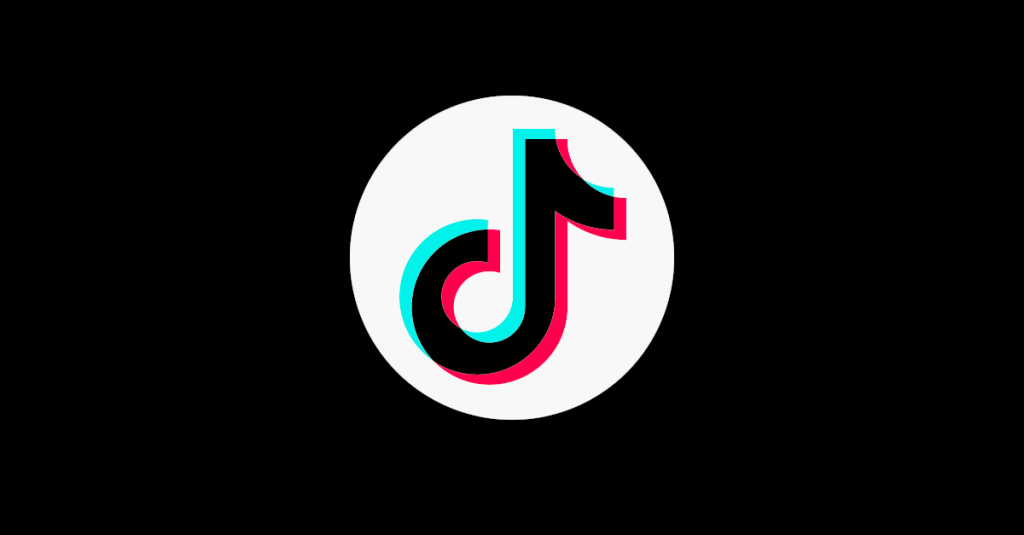

Overview and Company History:
TikTok is a video-sharing app whose algorithm is geared towards growth. That means that it’s relatively easy to have content go viral and build a following on this app.
TikTok is a social media platform through and through, but when businesses use it strategically, they can lead viewers to their websites for their intended conversion.
Basic Functionality:
The majority of TikTok users are Gen Zers, which means that most viewers on the platform are around the age of 25 and younger. This option is best suited for businesses with a younger audience.
Key Features:
TikTok has some live streaming tools,TikTok has some live streaming tools, but the platform is primarily used for sharing short video clips.
Detailed Features:
- Restricted live streaming tools
- 15-60 second video clip sharing
- Feed that generates content suggestions based on viewers’ behavior
- Young audience
Pros:
- Free to use
- Growth-centric algorithm
- Suitable for “going viral”
- Generates custom a “For You Page” based on viewer behavior
Cons:
- TikTok Live has its own requirements, such as needing at least 1,000 followers to go live.
- You can’t get rid of TikTok’s branding.
Upload Guidelines and Specs:
- Minimum dimension: 1080 x 1920
- Maximum dimension: 1080 x 1920
- Aspect ratio: 9:16
- Max file size: 287.6 MB on iOS and 72 MB on Android
- Max video length: 60 seconds
- Total file storage: No storage limit
- Compatible video formats: MP4, MOV
Pricing:
TikTok is free to use. It primarily focuses on short-form videos, but it also offers live streaming. However, it lacks some advanced features found in dedicated live-streaming solutions.
24. X (formerly Twitter) Live


Overview and Company History:
X Live, previously known as Twitter Live, is the live streaming feature of X (formerly Twitter). It allows users to broadcast live content directly on their profiles, engage with followers in real time, and enhance their content strategy.
Basic Functionality:
X Live enables users to stream from their mobile devices or via external encoders. It is used by individuals, brands, and news organizations to provide live updates, discussions, and events.
Key Features:
- Live streaming via mobile or external encoders
- Audience interaction through comments and reactions
- Stream embedding capabilities
- Integration with Periscope Producer for advanced broadcasting
Detailed Features:
- Instant sharing with X followers
- Monetization via paid promotions
- No streaming limits for verified accounts
- High engagement potential for trending topics
Pros:
- Large built-in audience
- Easy to use and share
- Works with third-party streaming tools
Cons:
- Limited monetization options
- No built-in pay-per-view features
Upload Guidelines and Specs:
- Recommended dimension: 720p (1280 x 720)
- Aspect ratio: 16:9
- Max file size: 1GB
- Max video length: No set limit for verified users
- Compatible video formats: MP4, MOV
Pricing:
X Live is free to use, but advanced features may require additional tools or software. For real-time engagement, X Live is a great social streaming solution.
25. Kick


Overview and Company History:
Kick is a relatively new live-streaming platform launched in 2022. It was created to offer streamers a better revenue-sharing model compared to Twitch. With a strong focus on gaming and entertainment, Kick has quickly grown in popularity.
Basic Functionality:
Kick allows users to live stream gaming, entertainment, and IRL content. It is designed as an alternative to Twitch, with fewer content restrictions and a higher revenue share for creators.
Key Features:
- High revenue share for streamers (95% to creators)
- 1080p live streaming at 60fps
- Built-in chat and audience engagement tools
- Subscription and donation features
Detailed Features:
- Creator-friendly monetization
- Growing audience base
- No exclusivity restrictions
- Support for third-party streaming software
Pros:
- High payout percentage for streamers
- A competitive alternative to Twitch
- Easy onboarding process
Cons:
- Still a developing platform
- Smaller audience than Twitch and YouTube Live
Upload Guidelines and Specs:
- Recommended dimension: 1080p (1920 x 1080)
- Aspect ratio: 16:9
- Max file size: Varies by bandwidth
- Max video length: No limit
- Compatible video formats: MP4, MOV
Pricing:
Kick is free to use, but revenue is generated through subscriptions, donations, and ad-sharing programs.
Kick is a solid choice for streamers looking for an alternative to Twitch with better monetization options.
Live Streaming Technology
As you compare live streaming solutions, it is important to consider other related technology in terms of compatibility. The reason that this is so important is that all of the moving parts must work together seamlessly.
A few of the other technology requirements include a camera, encoder, mixing software, a switcher, production software, and simulcasting tools. Each of these components is available at a variety of price points for different use cases.
Many of these pieces of technology can be integrated with your live streaming solution as input. Many of the popular live streaming solutions use RTMP ingest, so if you choose a platform with that streaming setup, you’re going to want to choose associated technology that is compatible.
We recommend taking a look at our ultimate guide to live streaming technology to learn more. This guide explains both the backend of live streaming and the different equipment that make it possible.
FAQs
1. What is the best platform for live streaming?
The best live streaming platforms or services that you can use for live videos are:
- Dacast
- StreamYard
- Restream
- Resi
- Brightcove
- StreamShark
- IBM Cloud Video
- Cincopa
- JW Player
- Kaltura
- Muvi
- Panopto
- Vimeo Livestream
- Wowza
- Vidyard
- VPlayed
2. What is the most popular video streaming service?
Some of the most popular video streaming services are social media platforms owing to their massive reach and free access to livestreams. The top ones are YouTube Live, Twitch, Facebook Live, Instagram Live, TikTok, X, and Kick. LinkedIn also provides live streaming features to a selected number of users.
3. What is the #1 best streaming service?
The top streaming service out there for enterprise users is Dacast. It enables you to easily live stream your videos to viewers all around the globe, including China. Setting up your live streams is easy and you also get features like adaptive bitrate streaming that can help elevate the quality of your viewing experience.
4. Which server is best for live streaming?
The best sort of servers for live streaming are Nginx web servers. They can run on all major operating systems like Windows, Linux, and Mac. You can easily integrate them with HLS and RTMP for enabling live streaming with ease. This flexibility makes them the top servers to opt for when you want to do live streaming.
5. How do I set up a professional live stream?
Setting up a professional live stream is pretty straightforward. Here are the steps you can follow for the same:
- Select a professional live streaming service based on your requirements and budget.
- Purchase and set up equipment for the livestream.
- Choose the right settings for your livestream.
- Do a trial run to see if the stream is functioning well without any issues.
- Share the URL of the livestream with your audience in advance.
- Start streaming.
Conclusion
There is certainly a wide range of options available when it comes to professional streaming solutions. We hope that this article has helped you to understand the top online streaming solutions that are available today.
We believe that when assessing features and pricing, Dacast is the best live streaming platform for professionals. However, our goal is to provide the most up-to-date information possible to our readers.
If you haven’t decided firmly on which platform is for you, why not try our live streaming solutions for yourself? We offer a 14-day free trial, with no credit card required. Click here to sign up for our free trial and start streaming live today:
If you have any comments, let us know what you think! We love to hear from our readers. For regular tips on live streaming and exclusive offers, feel free to join our LinkedIn group.

 Connect
Connect
 Events
Events Business
Business Organizations
Organizations Entertainment and Media
Entertainment and Media API
API Tools
Tools Learning Center
Learning Center Support
Support Support Articles
Support Articles